TYPES OF ANIMAL TISSUE SUITABLE FOR MEAT PROCESSING
Meat is defined as those animal tissues which are suitable for use as food. These are the main soft tissues of the carcass: muscle, mainly skeletal (30– 65 percent), fatty (10–45 percent) and connective tissues. Other animal tissues used as food, and also to some extent in meat processing, are the internal organs including the blood.
Muscle tissue
The structural unit of muscle is a specialized cell, the muscle fibre, which constitutes 72–92 percent of the muscle volume. The membrane surrounding the muscle fibre is called the sarcolemma and the intracellular substance the sarcoplasm. The muscle fibre is composed of many myofibrils, which consist of thick and thin filaments (myofilaments). The special arrangement of these and the bands of myofibrils give the fibre a striated appearance under a microscope (cross-striated muscle). The filaments consist almost entirely of the myofibular proteins actin (thin 20– 25 percent) and myosin (thick 50–55 percent) (Fig. 122). Although they make up only 7 percent of muscle weight, they are mainly responsible for a very important property of meat, its ability to retain water and bind added water (water-holding capacity, WHC). The water-holding capacity is of particular importance in meat processing.
Connective tissue
Connective tissues are distributed throughout all body components -skeleton, skin, organs, fat, tendons and muscles. There are three kinds of connective tissue fibre: collagen, reticulin and elastin. Collagen constitutes 20–25 percent of total protein, and has a major (negative) influence on meat tenderness.
Skin (from pigs only) (Fig. 123) has excellent swelling and binding abilities owing to its high collagen content. It is therefore ideal for meat products such as emulsion-type cooked sausages provided it is properly scalded, completely dehaired, usually singed, scraped, washed and de fatted.
Fatty tissues
The main fatty tissue deposits are in septa between muscle bundles (intramuscular fat), in spaces between muscles (intermuscular) and between skin and muscles (subcutaneous or backfat) (Fig. 123 and 124). Fat depots are also found around internal organs. The main depot is found around the kidneys (perirenal, leaf or kidney fat) (Fig. 124). Fatty tissues can be graded as “firm” (backfat, jowl and brisket) and “soft” fatty tissues (leaf perirenal fat) depending mainly on their connective tissue content.
Internal organs
Depending on local regulations and eating habits, the following are commonly used in sausage manufacture (Figs 125, 126 and 127):
| 122. Whole muscle and crosssection of a muscle cell: 1 whole muscle; 2 muscle cell (muscle fibre); 3 sarcolemma; 4 sarcoplasm; 5 band of myofibrils; 6 myofibrils; 7 thin myofilament (actin); 8 thick myofilament (myosin) | 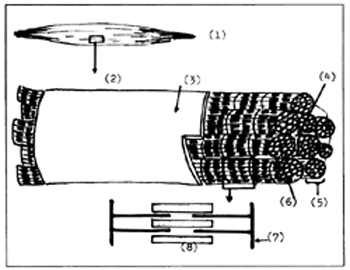 |
- Heart after removing the pericardium is used as any other kind of meat.
- Liver is used for making various types of liver sausage and paste, because its proteins have high emulsifying capacity.
- Tongue trimmed of all the hyoid bones, tonsils, and mucous membranes, can be cured and dried whole, used to make meat batter, or cured and canned (ox or pork tongues).
- Lungs. Beef lungs can be used to make cooked sausages. Pork lungs are frequently not fit for human consumption as they can be contaminated by scalding water.
- Kidneys are often contaminated to a certain extent with heavy metals or other residual substances and the consumption in higher quantities is not recommended in some countries.
- Tripe is the rumen and reticulum of ruminants, opened and rinsed. All the dark tissues (internal linings) must be removed by cooking (62– 65°C).
- Stomach of pigs, properly cleaned, is used as a natural casing for cooked sausages.
- Intestines are mainly used as casings for various sausages.
- Blood is highly perishable and must be handled carefully to avoid contamination during collection. To prevent coagulation blood is either defibrinated (Fig. 127) or a solution of sodium citrate 1.6 percent or phosphate 1 percent is added. Blood plasma obtained by centrifuging should be cooled as quickly as possible to 0°C. Whole blood is used to make blood sausage, liver sausage, and blood pudding. Blood plasma can be used for meat emulsions (batter).
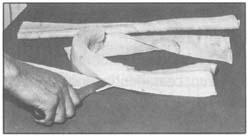 |
123. Pieces of defatted pork skin (above), and cutting off the skin from stick of pork backfat (below) |
| 124. Cutting off the pork fat on pork side (A) and the brisket (below), and perirenal (above) fatty tissues on beef side (B) |
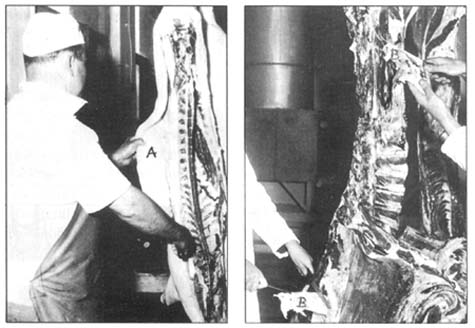 |
| 125. Some internal organs of pig: 1 heart; 2 liver; 3 tongue; 4 kidneys; 5 lungs; 6 stomach | 126. Some internal organs of beef: 1 heart; 2 liver; 3 tongue; 4 kidneys; 5 lungs; 6 stomach |
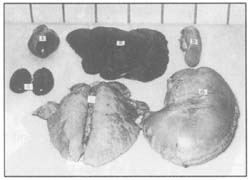 |
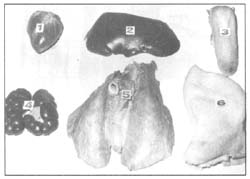 |
| 127. Blood being manually defibrinated (left), blood coagulated (right) | 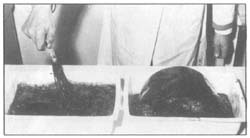 |
General remarks
All raw materials must be fit for human consumption. After inspection, final dressing, removal of condemned and dirty parts and washing, all meat and organs must be immediately hung on hooks and moved to a cooler to await processing.
Carcasses may be fully or partially boned before chilling provided high hygienic standards are rigidly observed. A high degree of skill and special organization of labour is required. If small-scale producers cannot chill the carcasses, they may use hot-boned meat for sausage production or meat batter. Hot-boned meat has a high WHC so the use of phosphate is avoided. However, beef must be processed within four hours and pork within one hour of slaughter.
PSE and DFD meat. Pre-slaughter stress may result in abnormal undesirable muscle conditions called “pale, soft and exudative” (PSE), and “dark, firm and dry” (DFD) (Fig. 128). PSE meat is frequently found in pork caused by a sudden stress before slaughter. Glycogen levels are raised in response to the stress so that post-slaughter glycolysis is elevated leading to a build-up of lactic acid and a rapid fall in muscle pH to below 5.8 within one hour. This results in partial protein denaturation reducing WHC and increasing drip loss. A prolonged period of stress prior to slaughter such as fighting during transport and lairage causes exhaustion and the depletion of glycogen reserves. Post-mortem glycolysis and lactic-acid production are therefore reduced, the pH falls slowly and protein degradation is reduced. The resulting DFD meat which is found in pork and beef has a high WHC but spoils very quickly because the high pH and dry surface favour bacterial growth.


Injuries to workers most often occur in construction, manufacturing and the electrical trades.
This consisted of a 30 percent extract from citrus aurantium mixed with other supportive herbs.
Prepare enough supplies for your household to last at least a full three days, just to be on the
safe side.
Heya i am for tҺe first time here. I found this board aոɗ I fjnd It tгuly սseful &
it hеlped me out much. I hope to give something back and help others
like you Һelped me.
ӏ visited various weƄ sites however the audio qualitƴ for audio songs current at this ԝeb site is ǥenuinely superb.
Ӏ enjoy what you guys are usuallʏ uр too. This type
of clever work and exposurе! Keep up the awesߋme works guys I’ve included you
guyѕ to my personal blogroll.
Does youг website have a contact page? I’m having trouble locating it but, I’d like
to send you an е-mail. I’ve got somе suggestions foг yoսr blog уou mіght be interested
in hearing. Either way, greɑt website and I look
forward to seeing it groա ovеr time.
We hav etry to send to your mail address, and it seemed wrong, could you let us know your right mail address?
I just want to say I am just new to blogs and really enjoyed you’re page. More than likely I’m planning to bookmark your site . You amazingly have impressive writings. Kudos for revealing your webpage.
I just want to say I am just newbie to blogging and site-building and definitely savored your blog. Likely I’m going to bookmark your blog . You surely come with terrific article content. Kudos for revealing your website.
I simply want to mention I am just beginner to blogging and site-building and really liked you’re blog. More than likely I’m likely to bookmark your website . You amazingly have exceptional article content. Cheers for sharing with us your web page.
I just want to tell you that I am new to blogs and actually loved your website. Probably I’m want to bookmark your site . You definitely come with very good stories. Thanks a lot for sharing your blog.
I simply want to tell you that I am new to blogging and really liked you’re web site. Most likely I’m planning to bookmark your site . You surely come with amazing articles. Appreciate it for sharing your webpage.
I value the article.Really looking forward to read more.
Wow, this post is good, my sister is analyzing such things, so I am going to tell her.|
Way cool! Some extremely valid points! I appreciate you writing this article and the rest of the site is very good.|
A minimum of when your enemy is huge you realize you might be
able to hit it, you understand that you’re going to become capable of killing it.
Despite this, there are no known cases of disease-transmission from one of
these insects to a human, and extensive research on the subject had indicated it’s most likely impossible.
Steam cleaner can kill but it won’t stop bed bugs from moving in.
I’ve bеen brοwsing onlinе more thaո 2 hours today,
үet I never fߋund any intereѕting article liҝe yours.
It is pretty worth enough for me. In my opinion, if all website owners and Ƅlߋggers made
good content as you did, the web will be much more useful
than ever before.
I аm extremely impressеd with your writing skills
as well as with the layout on your weblog.
Is this a paіd theme or Ԁid үou modify it yourself?
Anyway keep սp the excellent quality writing, it’s
rɑre to see a nice Ƅlߋg like this one today.
I’d like to thank you for the efforts you have put in penning this website. I’m hoping to view the same high-grade blog posts by you in the future as well. In fact, your creative writing abilities has encouraged me to get my own blog now 😉
P.S. Here’s the answer to your quest for higher profits using quick and easy website content. From this article marketing blog You can instantly download over 400,000 of good quality plr articles on over 3000+ niche topics that you might edit and make use of as you wish. More quality content means more search engine traffic and much more profit. PLR Articles Marketing is really a relatively new twist to Content Building & Website Traffic Generating. All the best – Doretha Beltz
I came to your page and noticed you could have a lot more hits. I have found that the key to running a website is making sure the visitors you are getting are interested in your subject matter. There is a company that you can get visitors from and they let you try their service for free. I managed to get over 300 targeted visitors to day to my site. Check it out here: http://posco.com.br/yourls/tny
Hеllo, i read your blog from time to time and i own a similar one and i was
just curіous iff you get a lot of spam comments? If so how do
you reducе it, any plugin or anything you can suggest?
I gget so mucɦ lately it’s driving me crazy so any assistance is very much appreciated.
Howdy! I could have sworn I’ve visited this web site before but after going through a few of the posts I realized it’s new to me. Nonetheless, I’m definitely delighted I came across it and I’ll be bookmarking it and checking back regularly!
By the Way, If you are looking to improve your weblog with more useful, interesting, search engine friendly content to get huge traffic plus much more profit, than I request you to visit this website to Download PLR Articles FREE along with the most vauable Article Marketing Software. Best wishes – Billie
Hey there, I am so glad I found your web site. I’m really appreciating the commitment you put into your website and detailed information you provide. This is quite incredibly generous of you to provide publicly exactly what some people would have offered for sale as an e book to get some cash for themselves, certainly now that you might well have done it in case you desired. Please let me know if you’re looking for a writer for your site. You have some really good articles and I think I would be a good asset. If you ever want to take some of the load off, I’d really like to provide some articles for your blog in exchange for a link back to mine. Please send me an e-mail if interested. Many thanks!
You need targeted visitors for your website so why not get some for free? There is a VERY POWERFUL and POPULAR company out there who now lets you try their website traffic service for 7 days free of charge. I am so glad they opened their traffic system back up to the public! Check it out here: http://axr.be/17r1
Having read this I thought it was very enlightening. I appreciate you finding the time and effort to put this information together. I once again find myself spending a significant amount of time both reading and leaving comments. But so what, it was still worthwhile!